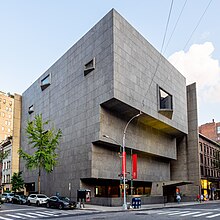Marcel Breuer
[2] Breuer extended the sculpture vocabulary he had developed in the carpentry shop at the Bauhaus into a personal architecture that made him one of the world's most popular architects at the peak of 20th-century design.
[3][4] Commonly known to his friends and associates as Lajkó (/ˈlaɪkoʊ/ LY-koh; the diminutive of his middle name),[5] Breuer was born in Pécs, Hungary, to a Jewish family.
After the school moved from Weimar to Dessau in 1925, Breuer returned from a brief sojourn in Paris to join older faculty members such as Josef Albers, Wassily Kandinsky, and Paul Klee as a Master, eventually teaching in its newly established department of architecture.
Recognized for his invention of bicycle-handlebar-inspired tubular steel furniture,[5] Breuer lived off his design fees at a time in the late 1920s and early 1930s when the architectural commissions he was looking for were few and far-between.
[8] He was known to such giants as Le Corbusier and Mies van der Rohe, whose architectural vocabulary he was later to adapt as part of his own, but hardly considered an equal by them who were his senior by 15 and 16 years.
[8] In 1937, Gropius accepted the appointment as chairman of Harvard's Graduate School of Design and again Breuer followed his mentor to join the faculty in Cambridge, Massachusetts.
[11] Breuer had married their secretary, Constance Crocker Leighton, and after a few more years in Cambridge, moved down to New York City in 1946[5] (with Harry Seidler as his chief draftsman) to establish a practice that was centered there for the rest of his life.
Breuer was a supporter of the Council for the Advancement of the Negro in Architecture (CANA) and employed Beverly Lorraine Greene, the first African-American woman to be licensed as an architect in the United States.
[12][22] Throughout the almost 30 years and nearly 100 buildings that followed, Breuer worked with a number of partners and associates with whom he openly and insistently shared design credit: Pier Luigi Nervi at UNESCO; Herbert Beckhard, Robert Gatje, Hamilton Smith and Tician Papachristou in New York, Mario Jossa and Harry Seidler in Paris.
In an ironic timing of events, it coincided with general criticism of one of America's favorite architects for his willingness to design a multi-story office building on top of Grand Central Terminal.
During his lifetime, Breuer rarely acknowledged the influence of other architects' work upon his own but he had certainly picked up the use of rough board-formed concrete from Le Corbusier and the noble dignity of his second New Canaan house seems to have directly descended from Mies' Barcelona Pavilion.
Shortly before his death, he told an interviewer that he considered his principal contribution to have been the adaptation of the work of older architects to the needs of modern society.




